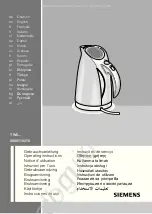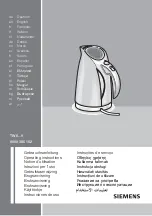
SEPTEMBER 12, 2014
2
FT-20CE ELECTRIC TILTING KETTLE
TROUBLESHOOTING
SAFETY VALVE MAINTENANCE AND TESTING
CAUTION
Under normal operating conditions a “try lever
test” should be performed every two months.
Under severe service conditions, or if corro-
sion and/or deposits are noticed within the
valve body, testing must be performed more
often. A “try lever test” should also be per-
formed at the end of any non-service period.
CAUTION
Hot, high pressure fluid may be discharged
from body drain and vent during “try lever”
test. Care must be taken to avoid any bodily
contact.
CAUTION
High sound levels may be experienced during
“try lever” test. Wear proper safety equip-
ment and exercise extreme care! Test at, or
near, half of the operating pressure by holding
the test lever fully open for at least two sec-
onds to flush the valve seat free of sediment
and debris. Then release lever and permit the
valve to snap shut.
If lift lever does not activate, or there is no
evidence of discharge, turn off equipment im-
mediately and contact a licensed contractor or
qualified service personnel.
ADDING WATER (LOW WATER LIGHT COMES ON)
It may be necessary to replenish water in the jacket when
the low water indicator comes on. Do so as follows:
1. Unit should be completely cold and off.
2. Lift handle of pressure relief valve to release vacuum
in kettle. (Relief valve is at left rear of kettle).
3. Remove air vent nut at the rear of the unit.
4.
Using pure distilled water only, pour 140 fl. oz. (4 L)
into the opening. (A funnel will be helpful). Water will
enter the kettle slowly, as air must escape through the
same hole.
5.
When sufficient water has been added, replace and
tighten the nut. Be sure to seal threads with a pipe
joint compound suitable for steam at 50 psi.
6. Vacuum must be re-established. (See Venting In-
structions).
VENTING INSTRUCTIONS
Check vacuum/pressure gauge when kettle is cold.
Gauge should be in the green vacuum zone (25 - 30 In.
Hg or 84 - 100 kPa). If not, air is present which must be
vented (removed) for proper heating. Use the following
procedures to vent air:
1. With the kettle empty, place power switch in ON posi-
tion.
2. Set temperature control thermostat to ‘10'. Heat ket-
tle until heat indicator light goes off.
3. Using a 7/16" wrench, open bleed vent (rear of kettle)
one full turn for 10 seconds and close.
4. Cool kettle. Check for proper vacuum in the green
vacuum zone (25 - 30 In. Hg or 84 - 100 kPa). If read
-
ing is not low enough, repeat steps 1 to 3.

































